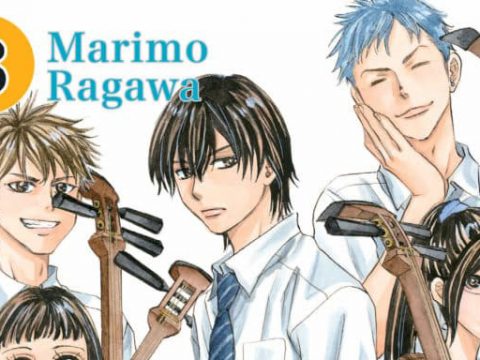 © 2014 Gou TANABE. All rights reserved. First published in Japan in 2014 by KADOKAWA CORPORATION ENTERBRAIN. English translation rights arranged with KADOKAWA CORPORATION ENTERBRAIN through TOHAN CORPORATION, Tokyo.
© 2014 Gou TANABE. All rights reserved. First published in Japan in 2014 by KADOKAWA CORPORATION ENTERBRAIN. English translation rights arranged with KADOKAWA CORPORATION ENTERBRAIN through TOHAN CORPORATION, Tokyo.The work of H.P. Lovecraft (1890-1937), the creator of octopus-headed Cthulhu and other horror icons, has inspired manga artists and authors ranging from the serious (Junji Ito’s slimy Uzumaki, Hideyuki Kikuchi’s pulp novels of demons and alien gods) to the not-so-serious (Toshio Maeda’s X-rated Urotsukidoji, the comedy harem manga Haiyore! Nyaruko-san). But despite some fans’ desire to see Cthulhu behind every tentacle monster, there’s relatively few “straight” manga adaptations of Lovecraft, whose is minfluence ore often diffused through general horror pop culture.
This collection by Gou Tanabe, an artist whose other works include Classics Illustrated-style adaptations of Maxim Gorky and Anton Chekov, adapts three of Lovecraft’s early short stories: “The Hound,” “The Temple,” and “The Nameless City.” Plot-light and atmosphere-heavy even by Lovecraft’s standards, all are variations on the same theme of a man alone in a frightening place, whether that man is an archaeologist exploring desert ruins (“The Nameless City”), a Nazi submarine commander whose crippled sub has sunk into a mysterious undersea world (“The Temple”), or a grave robber who, with the help of his Necronomicon-reading friend, finds a cursed artifact whose owners tend to end up torn to pieces (“The Hound”).
 Tanabe brings to the mayerial a detailed, heavily inked art style (almost overworked in places) and a talent for silence. The original stories were first-person narratives, but Tanabe does his best work when he removes the text and tells the stories with art alone: the expressions on a character’s face, the movements of a character’s body, the slow camera pan over the intricate settings of the submarine interior, the haunted graveyard, the desert tomb. By manga standards, it’s still a bit wordy, and in places (particularly “The Nameless City”) the text could be trimmed even further.
Tanabe brings to the mayerial a detailed, heavily inked art style (almost overworked in places) and a talent for silence. The original stories were first-person narratives, but Tanabe does his best work when he removes the text and tells the stories with art alone: the expressions on a character’s face, the movements of a character’s body, the slow camera pan over the intricate settings of the submarine interior, the haunted graveyard, the desert tomb. By manga standards, it’s still a bit wordy, and in places (particularly “The Nameless City”) the text could be trimmed even further.
Indeed, if these atmospheric adapations have a flaw, it’s that they’re too literal and reverential; Tanabe even disdains the time-honored horror-manga buildup to “turning the page to see the final shocking image,” but don’t you need a manic, gory, crazy, manga art style to visually convey the spirit of lines like “Madness rides the star-wind … claws and teeth sharpened on centuries of corpses … dripping death astride a Bacchanale of bats from night-black ruins of buried temples of Belial”?? The best of the three adaptations is “The Temple,” which conveys the strange beauty and awe which, in addition to slobbery monsters, typifies Lovecraft’s best work.
publisher: Dark Horse
story and art: Gou Tanabe
rating: Unrated/13+
This story appears in the December 2017 issue of Otaku USA Magazine. Click here to get a print copy.



![SSSS.Dynazenon [Anime Review] SSSS.Dynazenon [Anime Review]](https://otakuusamagazine.com/wp-content/uploads/2021/08/16-9-SSSS.Dynazenon_Key_Visual_3.5-480x360.jpg)
![Back Arrow [Anime Review] Back Arrow [Anime Review]](https://otakuusamagazine.com/wp-content/uploads/2021/07/ba15-02686-480x360.jpg)
![Dawn of the Witch [Manga Review] Dawn of the Witch [Manga Review]](https://otakuusamagazine.com/wp-content/uploads/2021/07/16-9-DawnoftheWitch-cvr_02-480x360.jpg)
![Nina The Starry Bride [Manga Review] Nina The Starry Bride [Manga Review]](https://otakuusamagazine.com/wp-content/uploads/2021/07/nina-the-starry-bride-v1-16-9-480x360.jpg)
![Sleepy Princess in the Demon Castle [Anime Review] Sleepy Princess in the Demon Castle [Anime Review]](https://otakuusamagazine.com/wp-content/uploads/2021/02/Maoujou-de-Oyasumi-ED-Large-06-480x360.jpg)